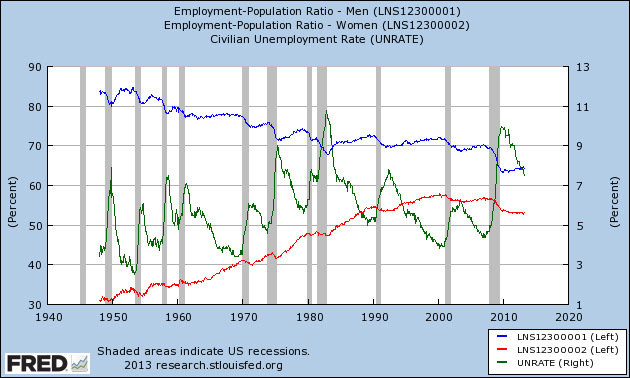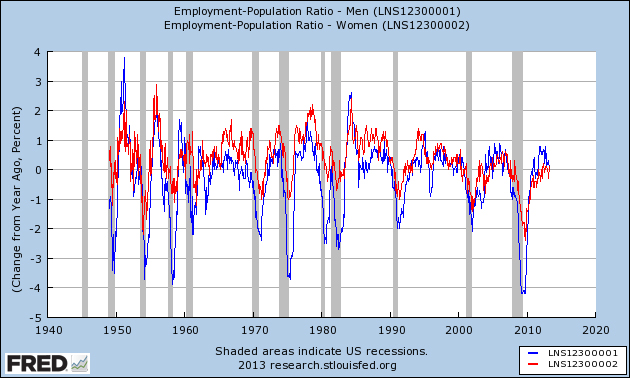It's actually a rather common thing to state that women are disproportionately affected by some issue - a quick Google search suggests those issues include AIDS, Climate Change, Freedom of Religion, Trade Sanctions, War, Poverty, Disease, Depression, Employment Competition, Conflict... well, and around 266,990 other things. Can women catch a break?
Well, I found at least one place where women have come out on top - employment in the United States over the last two generations!
The Employment Population Ratio
The employment-population ratio is no stranger to this blog, we last visited it back in February. We've also done one exposé on the difference in the sexes - based on unemployment rate. Of course, that article dates to 2011.
Let's refresh it for the present. The employment-population ratio hasn't changed much overall since them - but today we're more concerned with the employment population ratio broken down by gender. Below you've got the two ER ratios (left axis), versus the unemployment rate (right axis). Hopefully readable, and all seasonally adjusted.
And here's the same graph, but with the Male and Female ratios changed to year over year percentage change:
(Sidenote: isn't the St. Louis Fed great? Get the data there.)
World Ends! Men Hardest Hit!
Some observations, to kick of the analysis:
- In every recession except the last two (recessions are shaded in the above graphs), the female employment population ratio recovered and made new heights after the recession.
- In every recession except the Recession of 1949 and the recession from 7/81 to 11/82, the male employment population ratio settled at a lower level than it's previous peak.
- In the second chart, you can see that in every single recession since data collection started in the late 1940s females have had less decline in their ER than males.
So, I suppose the takeaway is this: in our employment article, we said that the recent recession (the so-called Great Recession) was a lot harder on men than women. We didn't make a strong enough point... even though evidence suggested it in our 2011 piece, we're ready to say it now: recessions in the last two generations have been much harder on men than women.
Is This a Good Thing?
Sure, we're getting more equality between sexes. At this pace, (I recognize the dangers of extrapolation, but follow me here) we're going to see parity reached in a generation... with both sexes sending less than 60% of their populations into the workforce.
Stated another way - not much has done more for workplace equality, at least between men and women, than recessions. Critical thinking time - if you were a policy maker, how would you react to the data? How would you describe an 'ideal' employment ratio overall, and further, an ideal ratio for men and women? Discuss! 70% & 50/50? 50% & 70/30? Let's hear your arguments!


